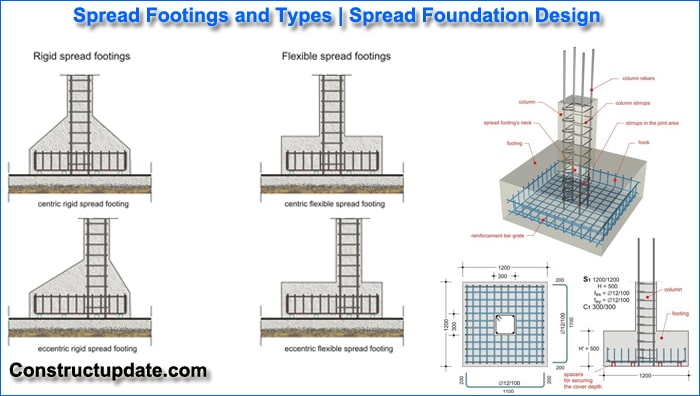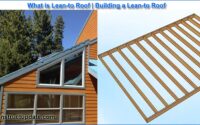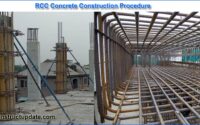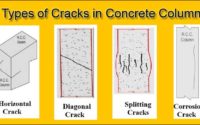What is Spread Footing | Design of Spread Footings | 8 Types of Spread Foundation | Spread Footing Advantages and Disadvantages
What Is Spread Footing and How Does It Work?
Spread footings are utilised in the construction of the building to provide a stable foundation for the columns and walls. The load from the structure is delivered and transmitted to the ground via spread footing.
A shallow foundation is known as a spread foundation. Spread foundations are often employed as a building’s foundation. The spread foundation extends or spreads to the structure’s individual support curves. Open excavation is commonly used to build spread foundations.
This sort of footing can come in a variety of shapes, including round, square, and rectangular. To transfer the building’s high load, this form of footing is sometimes done utilising a step approach.
Spread Foundation
In the case of a bridge, the spread foundation enlarges at the bottom to provide individual support to the column or bridge abutment. Many of the varieties of spread foundation can be found under shallow foundation.

Types of Spread Foundation
- Wall footing
- Isolated footing or column footing
- Combined footing
- Strap footing or cantilever footing
- Continuous footing
- Inverted arch footing
- Grillage footing
- Raft foundation or mat foundation
Wall footing
Simple or immersed wall footings are available. Light loads are carried by simple footings, while large loads are carried by stepped footings.
A simple footing has only one projection on each side of the wall, whereas stepped footings have many projections on each side.
Isolated Footing
The most frequent type of shallow foundation built around the world is isolated footings, often known as column footings. Furthermore, as compared to other types of foundations, shallow foundations are easier to design and construct due to their simplicity.
Combined Footing
When two columns are close to each other and their individual footings overlap, a combined footing is necessary. This footing supports two columns and can be trapezoidal or rectangular.
Strap Footing
A strap footing is a part of the foundation of a building. It’s a sort of composite footing that connects two or more column footings with a concrete beam. A strap beam is a name for this type of beam.
A strap footing is made up of two or more separate footings that are joined by a strap beam. It’s also known as a cantilever foundation or a pump handle foundation.
Continuous Footing
The foundation that supports more than two columns is known as a continuous footing. The footing is similar to a wall’s strip footing. When the weights are heavy, the loads from the individual columns are delivered either directly to the footing slab or through a longitudinal beam running lengthwise.
This type of foundation is appropriate for earthquake-prone areas and prevents differential settlement.
Continuous Spread Footing
More than two columns can be supported by this form of footing. The load from each individual column is conveyed directly to the footing with this form of footing. Continuous footing is when the column’s footings are connected to each other by a longitudinal beam.
In earthquake-prone areas, continuous footing is commonly used. During a natural disaster, this style of footing can be a compromise against mobility. Its purpose is to keep the constitutional movement from being jeopardised and to maintain stability.
Inverted Arch Spread Footing
Inverted Arch Footing was once utilised as a foundation for multistory structures. This form of foundation is employed when the soil’s carrying capacity is low and the structure’s load is carried to the footing via the walls. Where there is a concern, deep excavation can also be done.
Grillage Spread Footing
Grillage foundations are utilised to replace columns and piers with heavy structural loads on bearing capacity that is poor or non-existent.
As a shallow base, the grillage foundation is extremely beneficial. In which the footing is made up of more than two layers of beam. Which is used to distribute the load across a large area on the ground.
Raft Foundation
A raft foundation, also known as a mat foundation, is essentially a continuous slab sitting on the earth that runs the length of the building’s footprint, supporting it and distributing its weight to the ground.
Raft foundation is a combined footing that covers the entire region immediately beneath a structure and supports all of the walls and columns.
Concrete Spread Footing
The depth of footing should be sufficient to effectively resist punching shear and direct shear transferred by column load. In addition, the footing’s reinforcement should be built to withstand bending moments.
The dowels provided at the column-footing contact should suffice as a load transfer mechanism for the column. Spread footings are made of concrete and reinforced with steel to offer additional support.
When compared to spot footers, the load transferred by spread footing is distributed over a larger area and has a lower chance of failure.
Design of Spread Footing
Spread footings can be designed using a design technique, software, or by manually applying design formulas.
Design Procedure
Design Procedure is listed in a step by step manner,
Step 1– At the foundation level, determine the structural loads acting on the structure and various member sizes.
Step 2- After collecting all geotechnical data, the proposed footings are placed on factual and interpretive ground (geotechnical profile).
Step 3- After establishing the geotechnical profile, the depth and location of all foundation elements must be determined.
Step 4- Next, determine the carrying capacity of the soil on which the footing will be laid.
Step 5– Possible ground settlements in the form of total and differential settlement should be determined, and the impacts should be checked at 2B depths.
Step 6– To determine concrete strength, an appropriate grade of concrete is chosen.
Step 7– Choose a steel grade.
Step 8- Determine the dimensions of the required footing.
Step 9– Determine the thickness of the footing (T or D).
Step 10– The size of the footing must be determined, including the diameter of the bar, the number of bars, and the distance between them.
Step 11- Design the connection between the superstructure and the foundation
Step 12–The structure-soil system is checked for uplift and stability against sliding and overturning in the final step of the operation.
Advantages of Spread Footing:
- The spread footing transmits and dissipates the weight from the structure over a large area of soil beneath it for increased stability.
- Spread footing offers a low to nil chance of foundation failure when compared to other types of footing.
- This type of footing extends the life of structures by controlling damage within the structures.
- These footings are used to offer continuous support to the structure.
- These footings are simple to install within building structures and make basement construction simple.
- A variety footing foundation has a wider bottom portion than a load-bearing foundation, which provides greater stability across a larger area by spreading the structure’s weight.
- The most common materials used to construct this sort of foundation are concrete and reinforced steel.
- These footings are commonly used in residential building.
- Reduces settlement-related cracking.
- Stabilizes the earth at the structure’s base.
Disadvantages of Spread Footing:
- Not suited for all types of soil.
- You must fill the entire lot at once, but preparing such a large volume of concrete on your own is difficult.
- Pouring concrete requires quite a bit of effort, therefore you won’t be able to do it alone.





